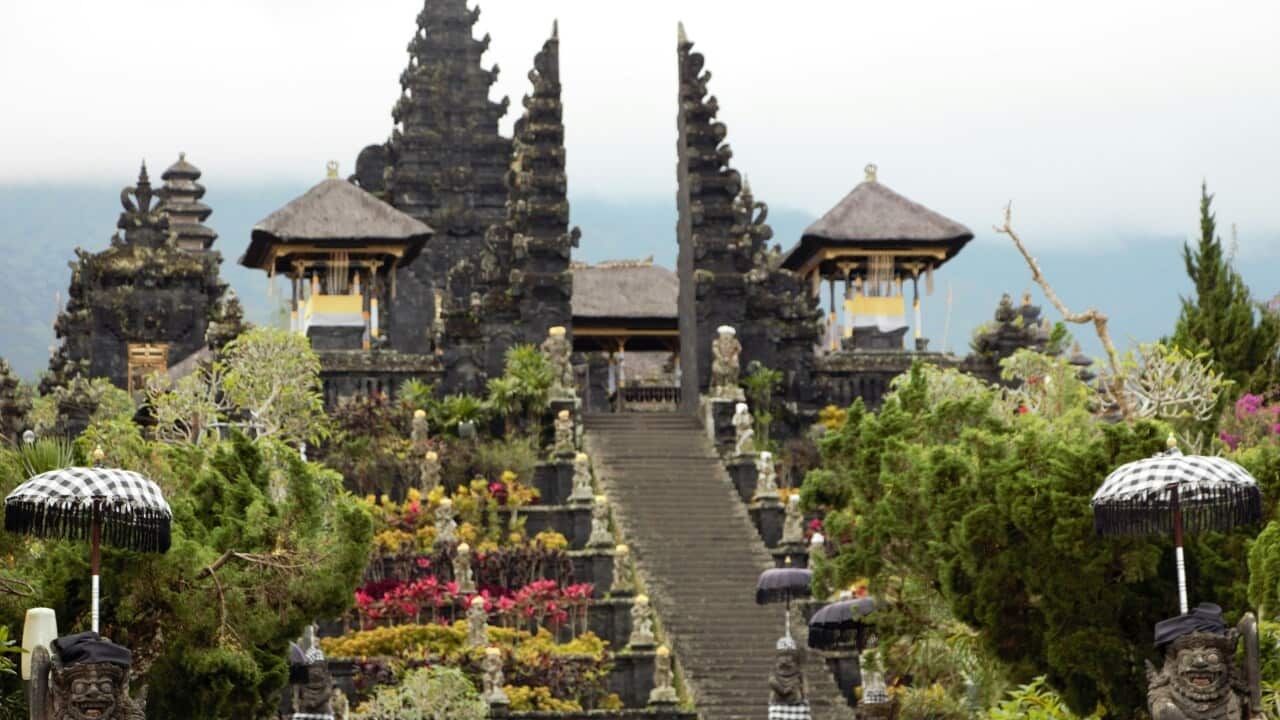The following tourist attractions reflect the original Balinese culture:
Kertha Gosa
Kertha Gosa is a heritage building or court hall complex of Semapura Palace from 1686 to 1908 and remained in operation during the Dutch colonial rule until 1942.
Credit: SBS Indonesian / RO
In this complex, at least the relics of Samarapura Palace remain, namely Kortagosa Hall, Kambang Hall with Taman Gili pool and the Palace Arch.
Kertha Gosa, an important historical building in Klungkung, Bali, harbors a rich history and architectural beauty.
The building once served as the highest court in the Kingdom of Klungkung, responsible for overseeing legal matters and resolving disputes.
The name “Kertha Gosa” translates to “Peaceful Jurisdiction,” reflecting its role as a place of justice and order.
Bale Kambang building which is surrounded by a pond, namely Taman Gili. Credit: SBS Indonesian/RO
The building is a masterpiece of Balinese architecture, showcasing intricate carvings and distinctive open-space designs. The most remarkable aspect, however, is the breathtaking Kamasan-style paintings that decorate the ceiling.
These paintings depict scenes from Hindu epics such as the Ramayana and Mahabharata, as well as moral lessons and philosophical concepts. These paintings are notable for their bright colours, intricate detailing, and superb storytelling.
Drawings at ceiling of Kertagosa Credit: SBS Indonesian – RO
Today, Kertha Gosa is a popular tourist attraction, drawing visitors from around the globe. It provides a fascinating insight into Bali’s rich cultural heritage and the complex workings of an ancient legal system.
The tranquil atmosphere, combined with the remarkable paintings, offers an unforgettable experience.
Mother of Temple Besakih
Pura Agung Besakih is a temple complex located in Besakih village, Kebatan Randang, Kepopelten, Karangasem, located on the western slope of Mount Agung.
In addition to its magnificent and unique Balinese architectural features, this temple also boasts a captivating natural landscape, with the majestic Mount Agung serving as a stunning backdrop.
Pura Besakih is not just a temple; it’s a sacred complex, the most important and holiest temple of Balinese Hinduism.
Nestled on the slopes of Mount Agung, Bali’s highest volcano, it’s a breathtaking sight, both physically and spiritually.
Rising majestically on the western slopes of Mount Agung, and referred to as the Mother Temple of Hindu Bali, is Pura Besakih Credit: Kementerian Pariwisata dan Ekkonomi Kreatif – Wonderful Indonesia
The complex is a sprawling network of 23 separate but interconnected temples, each dedicated to different Hindu deities.
Its intricate architecture, with terraced levels leading up to the main temples, reflects the layered nature of Balinese cosmology.
The Besakih temple complex was built based on the concept of Tri Hita Karana, which is a concept of harmony or balance of relationships with god, with nature and with fellow human beings, three relationships that create harmony in life.
Besakih Temple Credit: Photo by Andrey Bond on Unsplash
Within this complex, more than 70 annual rituals are held, symbolically uniting the temples into a single entity.
The cycle culminates in a centennial ceremony called Eka Dasarudera, which was last celebrated in 1979. Over recent decades, the Pura Besakih complex has undergone several architectural and ritual changes.
Religiously, Besakih serves as a venue for various festivals and ceremonies, offering visitors the chance to experience vibrant cultural performances, traditional music, and colorful processions.
Located few hours from Pura Besakih lies another tourist destination, namely Pengelipuran Village.
Penglipuran Village is known as one of the famous tourist villages in Bali with several nicknames, such as Adat Village, Wisata Village, Budaya Village, located in Bangli Regency, Bali Province, Indonesia.
Dating back to the era of the Bangli Kingdom, some 700 years ago, Penglipuran Village offers a glimpse into Bali’s ancient past.
Its well-preserved traditional layout and deep-rooted cultural practices continue to captivate visitors.
The village’s dedication to environmental conservation has been recognised with prestigious awards like Kalpataru, Indonesia Sustainable Tourism Award, and a place among the Top 100 Sustainable Destinations.
Not only that, the village has also been recognised by UNESCO as United Nation Tourism Best Tourism Village 2023.
Main street of Penglipuran Village Credit: SBS Indonesian / RO
The building’s design and the management of its surrounding land are based on the Tri Hatta Karana philosophy, a cornerstone of Balinese culture that emphasises the harmonious balance between the divine, humanity, and the natural world.
Credit: SBS Indonesian / RO
Penglipuran manages to establish tourism that benefits its entire society without losing its culture and customs.
These three tourist attractions in Bali unveil the soul of Bali’s rich heritage and not to be missed while visiting this Island of God.
Listen to every Monday, Wednesday, Friday and Sunday at 3pm.
Follow us on and , and don’t miss our .
